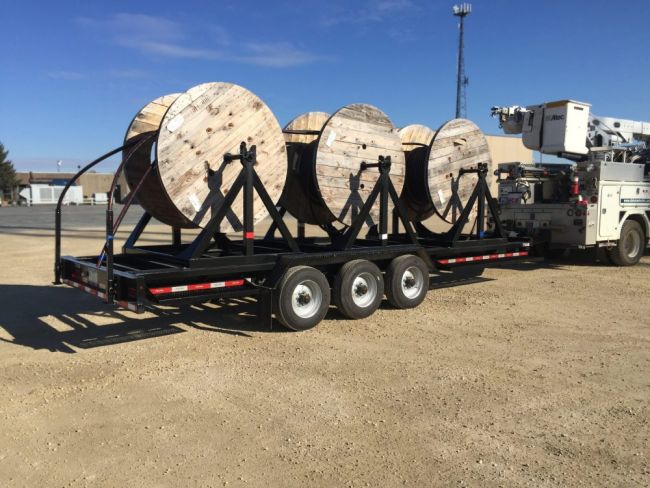
Spec’ing Cable Reel Trailers: 12 Common Errors to Avoid
Well-spec’d cable reel trailers enable utility crews to work safely and efficiently. But before they take ownership of new equipment, fleet professionals must successfully complete the spec’ing process – which means avoiding the many errors it’s possible to make. Three subject matter experts recently shared advice with UFP on sidestepping these 12 common spec’ing mistakes.
Mistake 1: Disregarding equipment operator preferences. “Talk to your lineworkers and operators to better understand their preferences,” said Donnie Bright, business development manager for Sherman+Reilly (www.sherman-reilly.com). “Some operators like high-tech, feature-packed machines, while some may prefer simpler operation. Get to know how your crew likes to work.” These insights can also help utility fleet managers identify the trailer specs required to meet the demands of various projects.
Mistake 2: Skipping the demonstration process. According to Kevin Tilley, president of Reelstrong Utility Fleet (www.reelstrongufleet.com), “Pictures are said to be worth 1,000 words, but getting your hands on a demo trailer is worth much more.” Fleets that try out demo units can assess trailer usability and effectiveness in real-world scenarios, providing invaluable hands-on knowledge.
Mistake 3: Assuming cable reel sizes will stay the same. Some fleet managers might assume that the reel sizes they are using today will remain consistent over time. Yet according to Mark Rapp, utility and telecom products manager for Felling Trailers (www.felling.com), reels in the electric utility and telecom markets are getting larger. Failing to factor in potential reel size increases during the spec’ing process could result in operational inefficiencies and necessitate rapid, pricey upgrades. So, while they may cost more initially, investing in cable reel trailers that can accommodate larger reels could eventually save fleets money.
Mistake 4: Ignoring capacity ratings. Reel capacity must be properly assessed to ensure that the trailer will meet job demands. A trailer that can’t handle its load weight could create significant operational hazards and increase equipment wear and tear. “If you’re within 10% of the rated reel capacity, give serious thought to bumping up to the next available axle package,” Rapp said.
Mistake 5: Failing to communicate all intended trailer applications. This could result in severe mismatches in expectations. During the spec’ing process, Rapp recommended that fleet managers ask vendors about the options available to enhance productivity and safety for each intended trailer application. Engaging in conversations about various uses helps fleet managers select features that can best protect workers and improve performance.
Mistake 6: Incorrectly sizing a trailer. Bright said incorrect sizing is “the most common and obvious mistake” when spec’ing cable reel trailers. It is vital for a fleet manager to know the maximum reel diameter, the reel width and weight, and the arbor hole size to verify that the trailer can accommodate them. Evaluating these factors upfront prevents the frustration of trying to work with an insufficient trailer during daily operations.
Mistake 7: Overlooking safety features. User safety should be the primary concern when spec’ing a cable reel trailer. Bright emphasized that the wrong spec can lead to compromised safety, increased maintenance costs and downtime, and a shorter equipment lifespan. Ensure that trailers are built with essential safety features and can withstand job demands. Valuing and prioritizing safety protects workers while reducing the risks of costly accidents and operational downtime.
Mistake 8: Neglecting the load rating of the reel bar/arbor. For example, Rapp said that “a reel bar rated for 5,000 pounds on a 60-inch-wide reel may fail when a narrower reel of the same weight is used.” Understanding reel-bar load ratings helps to prevent serious issues that can arise when equipment is incorrectly matched with its intended use.
Mistake 9: Not evaluating terrain or environment. Rapp also advised fleet managers to keep worksite conditions in mind; that’s because the operational environment plays a significant role in determining trailer specs. Consider whether the trailer will be used in urban and/or rural settings and how the terrain could affect equipment needs. Urban environments often necessitate smaller, more maneuverable trailers while rural applications may allow for larger configurations.
Mistake 10: Failing to consider tongue weight. Per Tilley, “You will want to maintain 10-15% tongue weight to help ensure stable towing conditions.” Tongue weight that is too high or too low can hinder control of both the cable reel trailer and the tow vehicle. Properly assessing the maximum tongue weight capacity of the tow vehicle helps to prevent complications while in transit.
Mistake 11: Over-spec’ing equipment. A fleet manager who over-specs a trailer, Tilley said, “may end up with a larger, more complicated piece of equipment that costs you more time and money in the long run.” Striking the right balance between adequate specs and operational simplicity is crucial to maximizing productivity and safety.
Mistake 12: Not calculating TCO. Be sure to evaluate a cable reel trailer’s total cost of ownership, not just its initial purchase price; doing so can provide fleet managers with a greater understanding of the equipment’s long-term maintenance expenses, which will ultimately affect budgets and operational planning. Rapp also suggested asking about the trailer’s warranty details, including the duration and what it covers.
About the Author: Grace Suizo has been covering the automotive fleet industry since 2007. She spent six years as an editor for five fleet publications and has written more than 100 articles geared toward both commercial and public sector fleets.

